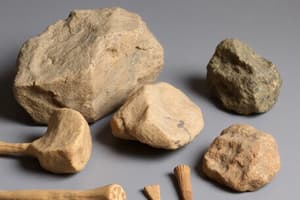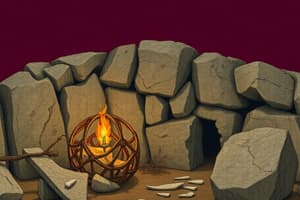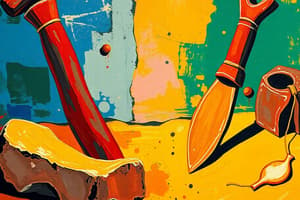Podcast
Questions and Answers
What are Mode II stone tools characterized by?
What are Mode II stone tools characterized by?
- Bifacial, pointed and convex features (correct)
- Use of fire in production
- Obsidian material usage
- Flexible and finest features
Which hominin is associated with the production of Acheulean tools?
Which hominin is associated with the production of Acheulean tools?
- Homo habilis
- Homo neanderthalensis
- Homo erectus (correct)
- Homo sapiens
What significant change occurred during the Neolithic period?
What significant change occurred during the Neolithic period?
- Transition to a sedentary lifestyle (correct)
- Use of stone tools
- Development of language
- Invention of fire
Which of the following sites is not mentioned as a vital Stone Age community site?
Which of the following sites is not mentioned as a vital Stone Age community site?
What was a key feature of the Paleolithic period?
What was a key feature of the Paleolithic period?
Which tool type is associated with Homo habilis?
Which tool type is associated with Homo habilis?
Which crop was notably domesticated during the Neolithic Revolution?
Which crop was notably domesticated during the Neolithic Revolution?
What tool characteristic is associated with Mode III stone tools?
What tool characteristic is associated with Mode III stone tools?
What was one of the items that Pharaoh Sahure sent expeditions to collect from Punt?
What was one of the items that Pharaoh Sahure sent expeditions to collect from Punt?
Which Egyptian queen is best known for describing expeditions to Punt?
Which Egyptian queen is best known for describing expeditions to Punt?
Which of the following items was exported from Punt to Egypt?
Which of the following items was exported from Punt to Egypt?
What was the significance of the title 'Mukarib' used by the king of Da’amat?
What was the significance of the title 'Mukarib' used by the king of Da’amat?
Which of the following gods was NOT mentioned as part of the Da’amat pantheon?
Which of the following gods was NOT mentioned as part of the Da’amat pantheon?
What commodities were likely stored at Yeha, the trade center in northern Ethiopia?
What commodities were likely stored at Yeha, the trade center in northern Ethiopia?
Which location has been suggested as a possible site for Punt?
Which location has been suggested as a possible site for Punt?
What is an example of an item imported from Egypt to Punt?
What is an example of an item imported from Egypt to Punt?
What is one main purpose of studying history?
What is one main purpose of studying history?
How do historians differentiate themselves from propagandists?
How do historians differentiate themselves from propagandists?
Which of the following is considered a primary historical source?
Which of the following is considered a primary historical source?
What defines a secondary source?
What defines a secondary source?
Why are new sources important to historical work?
Why are new sources important to historical work?
What type of data is known as oral tradition?
What type of data is known as oral tradition?
Why might historians be cautious about their interpretations?
Why might historians be cautious about their interpretations?
What event contributed to the revival of the movement led by Ewostatewos' followers?
What event contributed to the revival of the movement led by Ewostatewos' followers?
Which of these is NOT a characteristic of primary sources?
Which of these is NOT a characteristic of primary sources?
Which monastic communities were significant for sustaining the Ewostatewos movement?
Which monastic communities were significant for sustaining the Ewostatewos movement?
What was a key action taken by Emperor Zara-Yaqob to consolidate the Orthodox Church?
What was a key action taken by Emperor Zara-Yaqob to consolidate the Orthodox Church?
Who founded the Estifanosite movement?
Who founded the Estifanosite movement?
What was the main reason for Zara-Yaqob's conflict with the Estifanosites?
What was the main reason for Zara-Yaqob's conflict with the Estifanosites?
Which of the following works was NOT written by Emperor Zara-Yaqob?
Which of the following works was NOT written by Emperor Zara-Yaqob?
What transformation occurred regarding the Estifanosite movement in the 16th century?
What transformation occurred regarding the Estifanosite movement in the 16th century?
What factor contributed to the rise of Muslim sultanates in the 14th century?
What factor contributed to the rise of Muslim sultanates in the 14th century?
What was the primary agricultural technology used in the highland areas of the ancient states?
What was the primary agricultural technology used in the highland areas of the ancient states?
Which rights did peasants in the north hold with respect to land?
Which rights did peasants in the north hold with respect to land?
What was the role of a bale-rist in the land tenure system?
What was the role of a bale-rist in the land tenure system?
What is meant by the term 'gult right' in the context of the land tenure system?
What is meant by the term 'gult right' in the context of the land tenure system?
What suggestion arose in Europe regarding the Kingdom of Prester John?
What suggestion arose in Europe regarding the Kingdom of Prester John?
What agricultural practices were utilized to enhance soil fertility?
What agricultural practices were utilized to enhance soil fertility?
What was the significance of the letter attributed to Prester John in 1165?
What was the significance of the letter attributed to Prester John in 1165?
Which of the following was NOT mentioned as an indigenous handcraft technology?
Which of the following was NOT mentioned as an indigenous handcraft technology?
What was the primary trade item exchanged in the long-distance trade between Aksum and Sasu?
What was the primary trade item exchanged in the long-distance trade between Aksum and Sasu?
What method of trade did Aksumite traders use that did not require both sides to see each other?
What method of trade did Aksumite traders use that did not require both sides to see each other?
Which Aksumite king is noted for expanding Aksum's territories beyond ancient Arabia?
Which Aksumite king is noted for expanding Aksum's territories beyond ancient Arabia?
What significant factor contributed to the decline of Aksum in the late 7th century?
What significant factor contributed to the decline of Aksum in the late 7th century?
What was one means of naval power for the Aksumite Empire?
What was one means of naval power for the Aksumite Empire?
Which significant conflict involved Aksumite interaction with the local prince Dhu-Nuwas?
Which significant conflict involved Aksumite interaction with the local prince Dhu-Nuwas?
What type of currency did Aksumite kings mint for trade during their reign?
What type of currency did Aksumite kings mint for trade during their reign?
Which region had significant cultural exchanges with Aksum during its peak?
Which region had significant cultural exchanges with Aksum during its peak?
Flashcards
History's Purpose
History's Purpose
Understanding how and why things change, and what aspects of society remain constant despite change.
Misuse of History
Misuse of History
Using the past to support a current political agenda, distorting the truth.
Primary Source
Primary Source
First-hand accounts or objects from the time period being studied.
Examples of Primary Sources
Examples of Primary Sources
Signup and view all the flashcards
Secondary Source
Secondary Source
Signup and view all the flashcards
Historical Sources Classification
Historical Sources Classification
Signup and view all the flashcards
Oral Sources
Oral Sources
Signup and view all the flashcards
Role of Historian
Role of Historian
Signup and view all the flashcards
Mode II stone tools
Mode II stone tools
Signup and view all the flashcards
Mode III stone tools
Mode III stone tools
Signup and view all the flashcards
Oldowan tools
Oldowan tools
Signup and view all the flashcards
Acheulean tools
Acheulean tools
Signup and view all the flashcards
Paleolithic Era
Paleolithic Era
Signup and view all the flashcards
Neolithic Revolution
Neolithic Revolution
Signup and view all the flashcards
Domestication of plants/animals
Domestication of plants/animals
Signup and view all the flashcards
Neolithic Period
Neolithic Period
Signup and view all the flashcards
Punt's Location
Punt's Location
Signup and view all the flashcards
Egyptian Expeditions to Punt
Egyptian Expeditions to Punt
Signup and view all the flashcards
Hatshepsut's Expedition
Hatshepsut's Expedition
Signup and view all the flashcards
Punt's Exports to Egypt
Punt's Exports to Egypt
Signup and view all the flashcards
Egyptian Exports to Punt
Egyptian Exports to Punt
Signup and view all the flashcards
Yeha
Yeha
Signup and view all the flashcards
Da'amat
Da'amat
Signup and view all the flashcards
Cultural Centers of Northern Ethiopia
Cultural Centers of Northern Ethiopia
Signup and view all the flashcards
Adulis Inscription
Adulis Inscription
Signup and view all the flashcards
Silent Trade
Silent Trade
Signup and view all the flashcards
Aksum's Foreign Relations
Aksum's Foreign Relations
Signup and view all the flashcards
Aksumite Currency
Aksumite Currency
Signup and view all the flashcards
Aksum's Naval Power
Aksum's Naval Power
Signup and view all the flashcards
Kaleb's Expansion
Kaleb's Expansion
Signup and view all the flashcards
Aksumite Decline
Aksumite Decline
Signup and view all the flashcards
Gabra Masqal's Legacy
Gabra Masqal's Legacy
Signup and view all the flashcards
Prester John
Prester John
Signup and view all the flashcards
Ethiopian Christian Kingdom
Ethiopian Christian Kingdom
Signup and view all the flashcards
What is agricultural technology used in ancient Ethiopian states?
What is agricultural technology used in ancient Ethiopian states?
Signup and view all the flashcards
Communal land tenure
Communal land tenure
Signup and view all the flashcards
Rist rights
Rist rights
Signup and view all the flashcards
Tribute collection
Tribute collection
Signup and view all the flashcards
Gult right
Gult right
Signup and view all the flashcards
Indigenous Handicrafts
Indigenous Handicrafts
Signup and view all the flashcards
Ewostatewos Movement
Ewostatewos Movement
Signup and view all the flashcards
Abba Absad
Abba Absad
Signup and view all the flashcards
Deqiqe Estifanos
Deqiqe Estifanos
Signup and view all the flashcards
Estifanosites
Estifanosites
Signup and view all the flashcards
Zara-Yaqob's Reforms
Zara-Yaqob's Reforms
Signup and view all the flashcards
Church-State Union
Church-State Union
Signup and view all the flashcards
Muslim Sultanates
Muslim Sultanates
Signup and view all the flashcards
Trade & Sultanate Growth
Trade & Sultanate Growth
Signup and view all the flashcards




